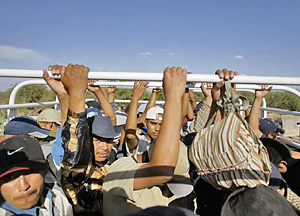 |
 |
 |
 Technology News | December 2006 Technology News | December 2006  
Mexico Offers SatNav to Illegals Crossing into the US
 Justin Stares - The Sunday Telegraph Justin Stares - The Sunday Telegraph


| | Migrants wait for transport along a dusty stretch of road known as The Brickyard to a remote area outside Sasabe where they can try to cross the border onto the Tohono O'odham Indian Reservation. (SF Chronicle/Carlos Avila Gonzalez) |
Would-be illegal immigrants planning to cross the desert and enter the United States on foot are to be given hand-held satellite devices by the Mexican authorities to ensure they arrive safely.

Those who get lost or fall sick during the dangerous four-day crossing will be able to activate the device, to alert frontier police on both sides of the border.

The satellite tracking service will require would-be illegals to register their intentions before setting off - a paradoxical move, given that secrecy is necessary for success - but Mexican authorities are predicting that about 200,000 devices will be handed out when the project is launched formally in the coming year.

"Our intention is to save lives," said Jaime Obregon, the coordinator for the state commission for migrants in Puebla, the Mexican state which is behind the project. "There are lots of people looking to cross and we are working with the US authorities to make sure they do not die on the way."

Between 20 and 30 migrants succumb to hellish temperatures and insect bites while trying to cross into Arizona every year. Heat exhaustion sometimes causes short-term memory loss, with trekkers wandering into the desert.

The route into Arizona, known as the Sasave Pass, is both the most common and the most dangerous way into the United States. According to Mexican state migrant authorities, up to 75,000 try the crossing every month, of whom 50,000 to 60,000 are caught by US border patrols and sent back.

The chance of success depends greatly on the knowledge of the guide, known as a "coyote" or "desert fox." They charge US$2,000 (HK$15,600) to US$10,000 per person.

Coyotes are merciless if a member of their pack lags behind. "If you cannot keep up they will abandon you." Obregon said. "Alone, you have about 36 hours to live. It is in this period the satellite device makes a difference."

A spokesman for US Customs and Border Protection said: "We do not have any information about the Mexican government providing satellite trackers to people, but we strongly discourage encouragement to people who are attempting to cross illegally into the United States." | 
 | |
 |



